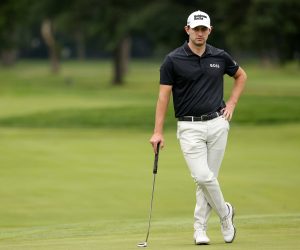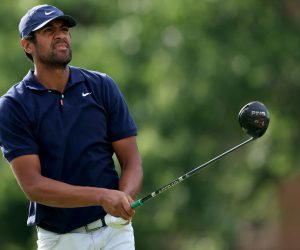We have compiled a complete list of Masters winners since the tournament began in 1934, as well as some of the historic moments from the most prestigious of golf’s four major championships. It might be the youngest of the bunch, but it is the most iconic, and has provided some of the most incredible moments in golf history.

Located on the site of a former nursery in Georgia, Augusta National Golf Club was started by famed amateur Robert Trent Jones and businessman Clifford Roberts, who was the first chairman of the tournament called The Augusta National Invitational Tournament because Jones thought “Masters” was too presumptuous.
A Tradition Unlike Any Other
Of the four Major golf tournaments, the Masters is the only one played at the same course every year. And the traditions at Augusta National make it special to golf pros and fans alike — a bucket-list pilgrimage for so many players.
“From the first time I drove up Magnolia Lane at age 19,” Jack Nicklaus said about the tree-lined entrance to the clubhouse, I had a special feeling about Augusta. Even today, I get chills.â€
Ben Hogan once noted that the Masters was an event he wanted to win more than any other. “If the Masters offered no money at all, I would be here trying just as hard,” Hogan said.
Built on the site of the former Fruitlands Nursery in Augusta, Georgia, more than 4,000 azaleas, dogwoods, honeysuckle and magnolias create the landscape for a course that is Three-time Masters champion Gary Player said of the course’s beauty, “If there’s a golf course in heaven, I hope it’s like Augusta National. I just don’t want an early tee time.â€
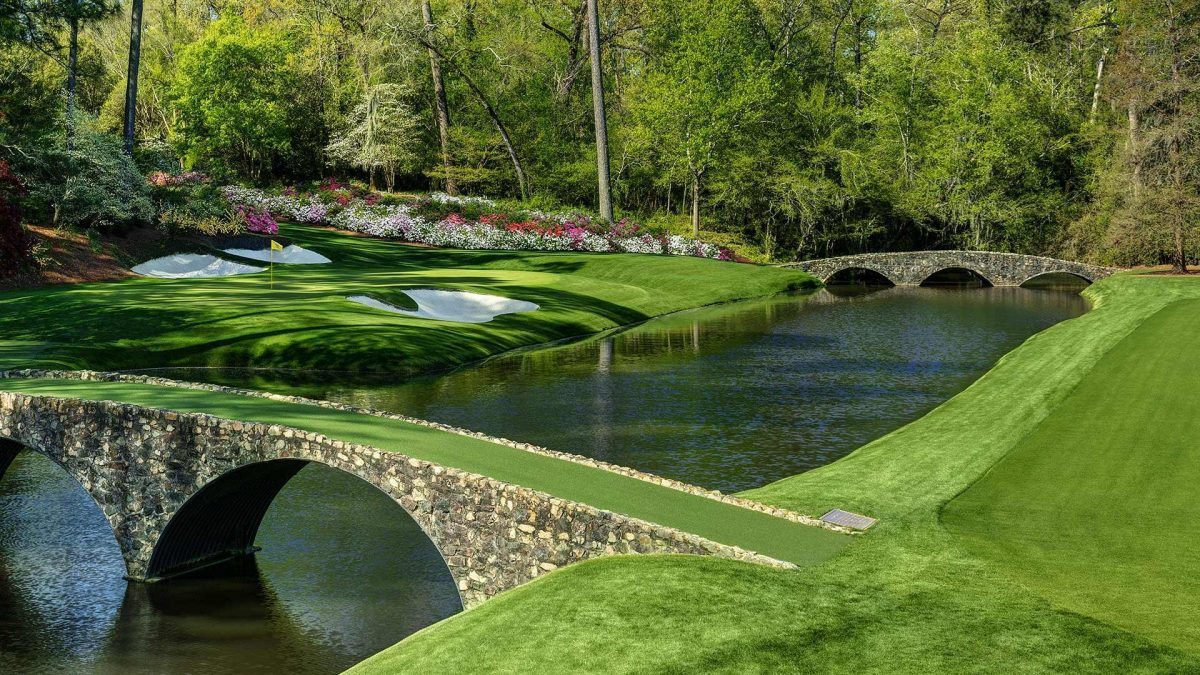
Legend of the Green Jacket
One of the strongest traditions of the Masters is the presentation of the green jacket to the winner. The idea began in 1937, as attire for members — thinking that fans at the course would be able to easily identify them and ask questions about the facility.
The first awarded to a player went to Sam Snead, when he won in 1949. (Previous winners received green jackets retroactively.) The piece of apparel was so coveted that when 1970 champion Billy Casper was buried with his when he died in 2015.
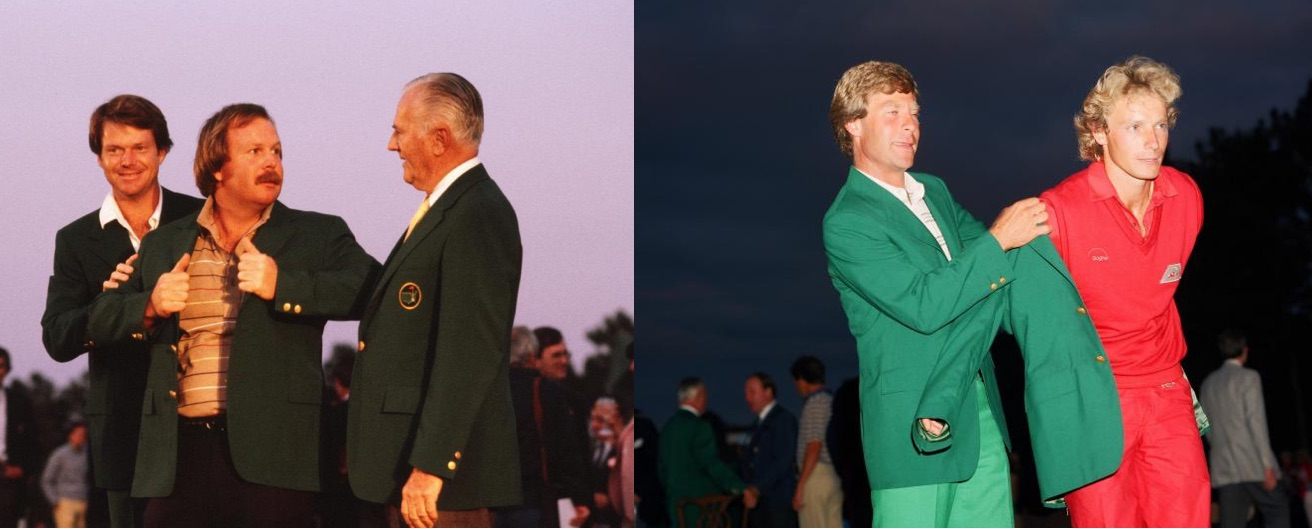
The Early Years: Masters Winners 1934-1950
When the Masters started, it was called The Augusta National Invitational Tournament, as Jones reportedly found the term “Masters” too presumptuous. in 1934. His Jones thought “Masters” was too presumptuous. off the first Masters in 1934, and the birth of the Masters began. Horton Smith won the first event, with Craig Wood the runner up. Wood would finish second the following year, too, this time to Gene Sarazen.
| Year | Winner | Runner Up |
| 1934 | Horton Smith | Craig Wood |
| 1935 | Gene Sarazen | Craig Wood |
| 1936 | Horton Smith | Harry Cooper |
| 1937 | Byron Nelson | Ralph Guldahl |
| 1938 | Henry Picard | Harry Cooper, Ralph Guldahl |
| 1939 | Ralph Guldahl | Sam Snead |
| 1940 | Jimmy Demaret | Lloyd Mangrum |
| 1941 | Craig Wood | Byron Nelson |
| 1942: | Bryon Nelson | Ben Hogan |
| 1943-1945 | No Tournament | World War II |
| 1946 | Herman Keiser | Ben Hogan |
| 1947 | Jimmy Demaret | Byron Nelson, Frank Stranahan |
| 1948 | Claude Harmon | Cary Middlecoff |
| 1949 | Sam Snead | Johnny Bulla, Lloyd Mangrum |
| 1950 | Jimmy Demaret | Jim Ferrier |
Horton Smith became the first two-time winner, when he captured his second green jacket in 1936. By 1939 Roberts had persuaded Jones to change the name of the tournament to “The Masters.” Though Jones played in 12 tournaments, he never won.
There were two more repeat champions before 1950, Jimmy Demaret, who won three times, and two-time winner Byron Nelson.
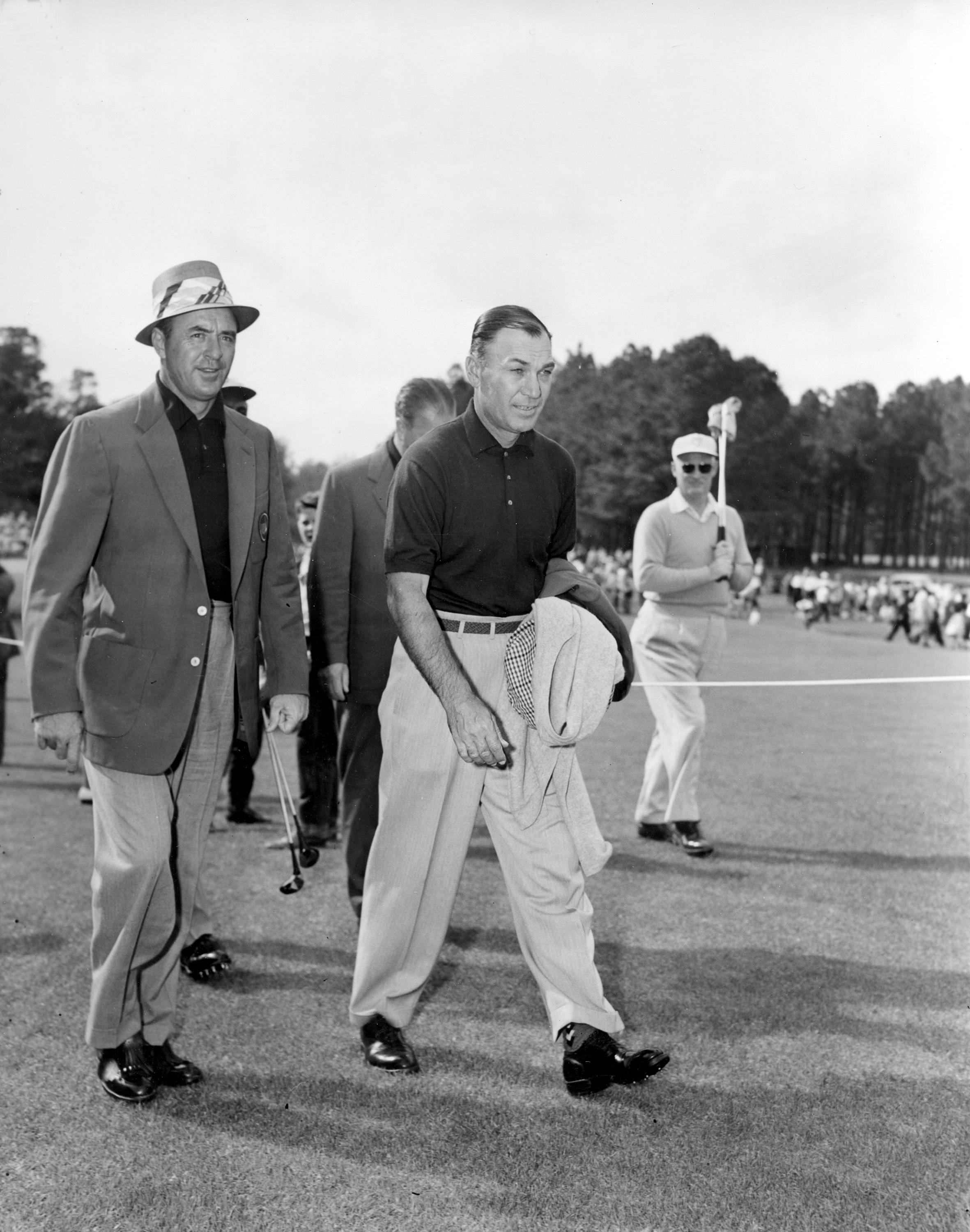
The Coming Television Age: Masters Winners 1951-1964
In the early 1950s, Ben Hogan and Sam Snead dominated the Masters. The two won the event from 1951 to 1954. Snead, who won in 1952 and 1954, also won in 1949, joining Demaret as a three-time winner. Hogan, who won in 1951 and 1953, was a runner up a then-record four times.
Both Hogan and Snead were the best golfers of their generation, and they would have several battles on the course throughout the years, including Augusta National.
| Year | Winner | Runner Up |
| 1951 | Ben Hogan | Skee Riegel |
| 1952 | Sam Snead | Jack Burke Jr. |
| 1953 | Ben Hogan | Ed Oliver |
| 1954 | Sam Snead | Ben Hogan |
| 1955 | Cary Middlecoff | Ben Hogan |
| 1956 | Jack Burke Jr. | Ken Venturi |
| 1957 | Doug Ford | Sam Snead |
| 1958 | Arnold Palmer | Doug Ford, Fred Hawkins |
| 1959 | Art Wall | Cary Middlecoff |
| 1960 | Arnold Palmer | Ken Venturi |
| 1961 | Gary Player | Charles Coe, Arnold Palmer |
| 1962 | Arnold Palmer | Gary Player |
| 1963 | Jack Nicklaus | Tony Lema |
| 1964 | Arnold Palmer | Dave Marr, Jack Nicklaus |
CBS has televised every Masters tournament since 1956. In 1958, with the tournament being broadcast to living rooms around America, the public met Arnold Palmer — a flashy young charismatic golfer from Latrobe, Pennsylvania — who won his first of four green jackets.
Palmer had a swashbuckling swagger and a swing that was once described as similar to a rusty gate. That distinctive style, however, earned him four Green Jackets and a legion of fans affectionately called Arnie’s Army.
The Golden Bear’s Time: Masters Winners 1965-1985
While Palmer had a stranglehold on the early sixties, he was soon challenged by a young college kid from Columbus, Ohio. Jack Nicklaus had already made a name for himself by winning in 1963, but it was the middle of the decade when he supplanted Palmer as the game’s greatest. He won the Masters in 1965 and 1966, becoming the first back-to-back winner in tournament history.
Golf fans hated that the likable Palmer was being pushed aside by Nicklaus, and many nicknamed him “Fat Jack.” It took several years for Nicklaus’ greatness to be recognized, and that began at Augusta National.
| Year | Winner | Runner Up |
| 1965 | Jack Nicklaus | Arnold Palmer, Gary Player |
| 1966 | Jack Nicklaus | Tommy Jacobs |
| 1967 | Gay Brewer | Bobby Nichols |
| 1968 | Bob Goalby | Robert DeVicenzo |
| 1969 | George Archer | Billy Casper, George Knudson, Tom Weiskopf |
| 1970 | Billy Casper | Gene Littler |
| 1971 | Charles Coody | Johnny Miller, Jack Nicklaus |
| 1972 | Jack Nicklaus | Bruce Crampton, Bobby Mitchell |
| 1973 | Tommy Aaron | J.C. Sneed |
| 1974 | Gary Player | Dave Stockton |
| 1975 | Jack Nicklaus | Johnny Miller, Tom Weiskopf |
| 1976 | Raymond Floyd | Ben Crenshaw |
| 1977 | Tom Watson | Jack Nicklaus |
| 1978 | Gary Player | Rod Funseth, Hubert Green, Tom Watson |
| 1979 | Fuzzy Zoeller | Ed Sneed, Tom Watson |
| 1980 | Seve Ballesteros | Gibby Gilbert, Jack Nicklaus |
| 1981 | Tom Watson | Johnny Miller, Jack Nicklaus |
| 1982 | Craig Stadler | Dan Pohl |
| 1983 | Seve Ballesteros | Ben Crenshaw, Tom Kite |
| 1984 | Ben Crenshaw | Tom Watson |
| 1985 | Bernhard Langer | Seve Ballesteros, Raymond Floyd, Curtis Strange |
Nicklaus would go on to win two more times in 1972 and 1975, but would save his most dramatic victory 10 years later. In addition to six green jackets, he finished second four times, matching Hogan’s record.
Challenging Nicklaus during that time was South Africa’s Gary Player. The diminutive golfer had already won in 1961, but grabbed two more green jackets in 1974 and 1978.
By 1986 Jack Nicklaus was considered past his prime. He hadn’t won at Augusta since 1975, and many thought his best days were behind him. He stunned the world when he won his sixth Masters, and 18th major championship, that year, two records that still stand today.
Course of Controversy
For as alluring as the notion of winning at Augusta National is to golfers, the world was changing and soon the Masters would have to wrestle with a past that took exclusivity to the level of discrimination. It wasn’t until 1975 that Lee Elder would become the first Black player to receive an invitation to the Masters.
It would be another 15 years before Augusta National, facing pressure from TV interests, would admit its first Black member in 1990. Tiger Woods became the first person of color to win the tournament in 1997, and at a celebration at the club, many of the club’s minority employees were seen peering through the windows.
While the color barrier may have been broken, it was still much later before anyone cracked through the glass tee box. Augusta National had been for men only until 2012, when they invited former Secretary of State Condoleezza Rice and South Carolina financier Darla Moore to become the first female members.
Parity Arrives: Masters Winners 1986-1996
The 1980s and ’90s were decades when no one golfer had a stranglehold on the PGA Tour. Other than back-to-back victories by Nick Faldo over Raymond Floyd (1989-90) this was an era golf parity was all the buzz, as lesser-known pros such as Sandy Lyle and Ian Woosnam pulled out surprise wins.
| Year | Winner | Runner Up |
| 1986 | Jack Nicklaus | Tom Kite, Greg Norman |
| 1987 | Larry Mize | Seve Ballesteros, Greg Norman |
| 1988 | Sandy Lyle | Mark Calcavecchia |
| 1989 | Nick Faldo | Raymond Floyd |
| 1990 | Nick Faldo | Raymond Floyd |
| 1991 | Ian Woosnam | Jose Maria Olazabal |
| 1992 | Fred Couples | Raymond Floyd |
| 1993 | Bernhard Langer | Chip Beck |
| 1994 | Jose Maria Olzabal | Tom Lehman |
| 1995 | Ben Crenshaw | Davis Love III |
| 1996 | Nick Faldo | Greg Norman |
This also was the age where Augusta National finally began putting its demons to rest — admitting the club’s first black member in 1990.
Tiger Woods Generation: Masters Winners 1997-2019
When 21-year-old Tiger Woods arrived at Augusta National for his first Masters as a professional, the buzz was whipping through the Georgia pines. Woods didn’t disappoint, dominating the 1997 tournament, winning by 12 strokes. It would be his first of five green jackets.
After Woods won in 1997, he went on to capture four more tournaments, and finish in second-place twice. Golfers such as Ernie Els and Retief Goosen attempted to assert their place, too, but fell short on multiple occasions.
| Year | Winner | Runner Up |
| 1997 | Tiger Woods | Tom Kite |
| 1998 | Mark O’Meara | Fred Couples, David Duval |
| 1999 | Jose Maria Olazabal | Davis Love III |
| 2000 | Vijay Singh | Ernie Els |
| 2001 | Tiger Woods | David Duval |
| 2002 | Tiger Woods | Retief Goosen |
| 2003 | Mike Weir | Len Mattiace |
| 2004 | Phil Mickelson | Ernie Els |
| 2005 | Tiger Woods | Chris DiMarco |
| 2006 | Phil Mickelson | Tim Clark |
| 2007 | Zach Johnson | Retief Goosen, Rory Sabbatini, Tiger Woods |
| 2008 | Trevor Immelman | Tiger Woods |
| 2009 | Angel Cabrera | Chad Campbell |
| 2010 | Phil Mickelson | Lee Westwood |
| 2011 | Charl Schwartzel | Jason Day, Adam Scott |
| 2012 | Bubba Watson | Louis Oosthuizen |
| 2013 | Adam Scott | Angel Cabrera |
| 2014 | Bubba Watson | Jonas Blixt, Jordan Spieth |
| 2015 | Jordan Spieth | Phil Mickelson, Justin Rose |
| 2016 | Danny Willett | Jordan Spieth, Lee Westwood |
| 2017 | Sergio Garcia | Justin Rose |
| 2018 | Patrick Reed | Rickie Fowler |
| 2019 | Tiger Woods | Dustin Johnson, Brooks Koepka, Xander Schauffele |
| 2020 | ??? | ??? |
Only Phil Mickelson was able to challenge Woods stature. It took more than a decade of frustration before Mickelson finally joined the green jacket club. The lefty captured his first Masters title in 2004, then won two more in 2006 and 2010.
After 2010, it seemed like a new generation was coming of age at Augusta. But before that could happen, Woods took down his 5th Masters last year, after more than a decade-long Augusta dry spell, telling golf fans his day wasn’t done.
